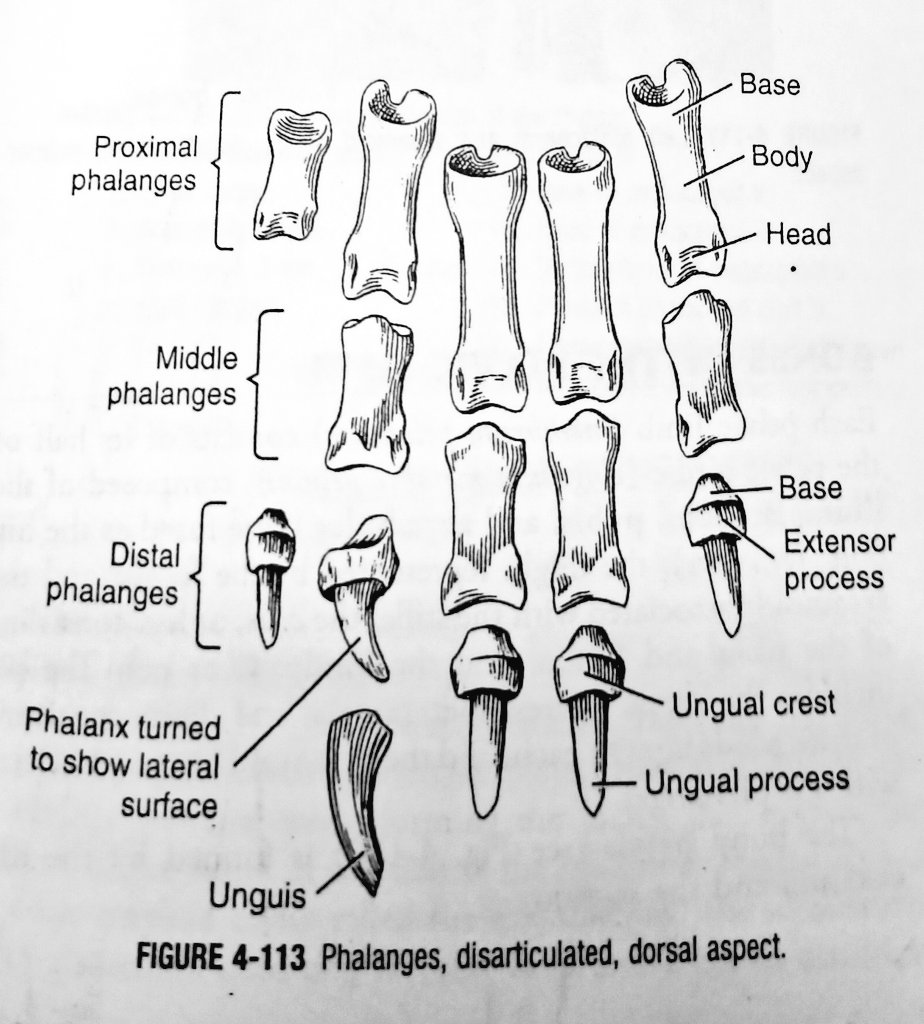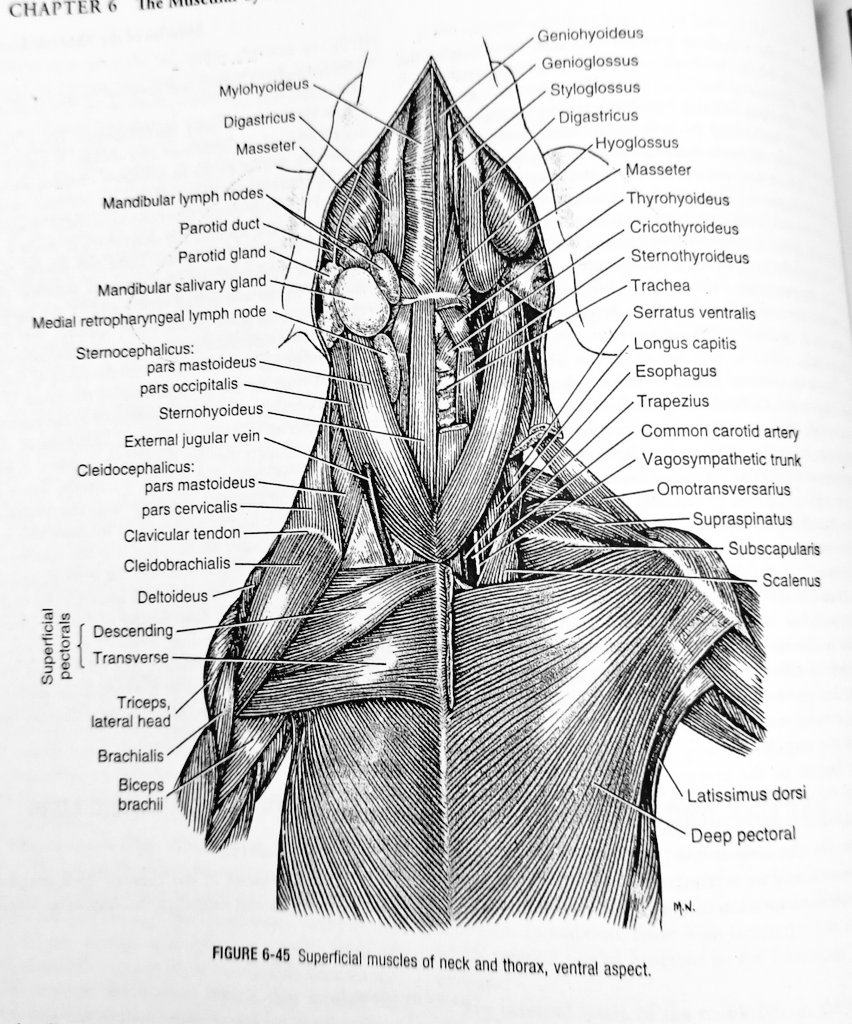ANATOMY  https://abs.twimg.com/emoji/v2/... draggable="false" alt="🦴" title="Bone" aria-label="Emoji: Bone">
https://abs.twimg.com/emoji/v2/... draggable="false" alt="🦴" title="Bone" aria-label="Emoji: Bone">
Joints [FCS-SAD]
1) Fibrous AKA Synarthrosis
2) Cartilaginous AKA Amphiarthrosis
3) Synovial AKA Diarthrosis
1) Fibrous AKA Synarthrosis
2) Cartilaginous AKA Amphiarthrosis
3) Synovial AKA Diarthrosis
Hinge/Ginglymus joint: atlanto-occipital joint = YES joint
Trochoid/Pivot joint: atlano-axial joint = NO joint
Ligament: BONE to BONE attachment [LB]
Tendon: MUSCLE to BONE attachment
Tendon: MUSCLE to BONE attachment
Bones of the THORACIC LIMB:
1) Thoracic girdle
- scapula & clavicle
2) Arm/Brachium
- humerus
3) Forearm/antebrachium
- radius & ulna
4) Forepaw/manus
- carpal bones, metacarpal bones, phalanges
1) Thoracic girdle
- scapula & clavicle
2) Arm/Brachium
- humerus
3) Forearm/antebrachium
- radius & ulna
4) Forepaw/manus
- carpal bones, metacarpal bones, phalanges
SCAPULA
 https://abs.twimg.com/emoji/v2/... draggable="false" alt="✅" title="Fettes weißes Häkchen" aria-label="Emoji: Fettes weißes Häkchen"> In dogs: ACROMION
https://abs.twimg.com/emoji/v2/... draggable="false" alt="✅" title="Fettes weißes Häkchen" aria-label="Emoji: Fettes weißes Häkchen"> In dogs: ACROMION
Note: If the NECK is broken, the muscle that will be affected mostly will be the
 https://abs.twimg.com/emoji/v2/... draggable="false" alt="✅" title="Fettes weißes Häkchen" aria-label="Emoji: Fettes weißes Häkchen"> Supraspinatus
https://abs.twimg.com/emoji/v2/... draggable="false" alt="✅" title="Fettes weißes Häkchen" aria-label="Emoji: Fettes weißes Häkchen"> Supraspinatus
 https://abs.twimg.com/emoji/v2/... draggable="false" alt="✅" title="Fettes weißes Häkchen" aria-label="Emoji: Fettes weißes Häkchen"> Infraspinatus
https://abs.twimg.com/emoji/v2/... draggable="false" alt="✅" title="Fettes weißes Häkchen" aria-label="Emoji: Fettes weißes Häkchen"> Infraspinatus
Glenoid cavity + Head of humerus = SHOULDER JOINT (ball and socket joint)
Note: If the NECK is broken, the muscle that will be affected mostly will be the
Glenoid cavity + Head of humerus = SHOULDER JOINT (ball and socket joint)
CLAVICLE
In https://abs.twimg.com/emoji/v2/... draggable="false" alt="🐶" title="Hundegesicht" aria-label="Emoji: Hundegesicht">: vestigial
https://abs.twimg.com/emoji/v2/... draggable="false" alt="🐶" title="Hundegesicht" aria-label="Emoji: Hundegesicht">: vestigial
In https://abs.twimg.com/emoji/v2/... draggable="false" alt="🐦" title="Vogel" aria-label="Emoji: Vogel"> &
https://abs.twimg.com/emoji/v2/... draggable="false" alt="🐦" title="Vogel" aria-label="Emoji: Vogel"> &  https://abs.twimg.com/emoji/v2/... draggable="false" alt="👨" title="Mann" aria-label="Emoji: Mann">: long
https://abs.twimg.com/emoji/v2/... draggable="false" alt="👨" title="Mann" aria-label="Emoji: Mann">: long
Origin for:
 https://abs.twimg.com/emoji/v2/... draggable="false" alt="✅" title="Fettes weißes Häkchen" aria-label="Emoji: Fettes weißes Häkchen"> Cleidobrachialis
https://abs.twimg.com/emoji/v2/... draggable="false" alt="✅" title="Fettes weißes Häkchen" aria-label="Emoji: Fettes weißes Häkchen"> Cleidobrachialis
 https://abs.twimg.com/emoji/v2/... draggable="false" alt="✅" title="Fettes weißes Häkchen" aria-label="Emoji: Fettes weißes Häkchen"> Cleidocephalicus
https://abs.twimg.com/emoji/v2/... draggable="false" alt="✅" title="Fettes weißes Häkchen" aria-label="Emoji: Fettes weißes Häkchen"> Cleidocephalicus
In
In
Origin for:
HUMERUS
LATERAL SIDE:
 https://abs.twimg.com/emoji/v2/... draggable="false" alt="✅" title="Fettes weißes Häkchen" aria-label="Emoji: Fettes weißes Häkchen"> Greater tubercle
https://abs.twimg.com/emoji/v2/... draggable="false" alt="✅" title="Fettes weißes Häkchen" aria-label="Emoji: Fettes weißes Häkchen"> Greater tubercle
 https://abs.twimg.com/emoji/v2/... draggable="false" alt="✅" title="Fettes weißes Häkchen" aria-label="Emoji: Fettes weißes Häkchen"> Teres minor tuberosity: insertion for TERES MINOR
https://abs.twimg.com/emoji/v2/... draggable="false" alt="✅" title="Fettes weißes Häkchen" aria-label="Emoji: Fettes weißes Häkchen"> Teres minor tuberosity: insertion for TERES MINOR
MEDIAL SIDE:
 https://abs.twimg.com/emoji/v2/... draggable="false" alt="✅" title="Fettes weißes Häkchen" aria-label="Emoji: Fettes weißes Häkchen"> Lesser tubercle
https://abs.twimg.com/emoji/v2/... draggable="false" alt="✅" title="Fettes weißes Häkchen" aria-label="Emoji: Fettes weißes Häkchen"> Lesser tubercle
 https://abs.twimg.com/emoji/v2/... draggable="false" alt="✅" title="Fettes weißes Häkchen" aria-label="Emoji: Fettes weißes Häkchen"> Teres major tuberosity: insertion for TERES MAJOR
https://abs.twimg.com/emoji/v2/... draggable="false" alt="✅" title="Fettes weißes Häkchen" aria-label="Emoji: Fettes weißes Häkchen"> Teres major tuberosity: insertion for TERES MAJOR
Groove bet. greater & lesser tubercle: INTERTUBERCULAR/BICIPITAL GROOVE
LATERAL SIDE:
MEDIAL SIDE:
Groove bet. greater & lesser tubercle: INTERTUBERCULAR/BICIPITAL GROOVE
Tendon of BICEPS BRACHII passes in this groove (INTERTUBERCULAR/BICIPITAL groove) and being held by a ligament called TRANSVERSE HUMERAL RETINACULUM
HUMERUS also has SUPRATROCHLEAR FORAMEN unique only to https://abs.twimg.com/emoji/v2/... draggable="false" alt="🐶" title="Hundegesicht" aria-label="Emoji: Hundegesicht">
https://abs.twimg.com/emoji/v2/... draggable="false" alt="🐶" title="Hundegesicht" aria-label="Emoji: Hundegesicht">
HUMERUS also has SUPRATROCHLEAR FORAMEN unique only to
Remember:
RADIUS = MEDIAL
U(L)NA = (L)ATERAL
RADIUS = MEDIAL
U(L)NA = (L)ATERAL
GROOVES OF THE RADIUS (distal end)
What TENDONS will pass through it?
LATERAL: Common Digital Extensor (CDE)
MEDIAL: Abductor Digiti 1 Longus (Extensor Carpi Obliquus)
MIDDLE: Extensor Carpi Radialis (ECR)
What TENDONS will pass through it?
LATERAL: Common Digital Extensor (CDE)
MEDIAL: Abductor Digiti 1 Longus (Extensor Carpi Obliquus)
MIDDLE: Extensor Carpi Radialis (ECR)
ULNA
 https://abs.twimg.com/emoji/v2/... draggable="false" alt="✅" title="Fettes weißes Häkchen" aria-label="Emoji: Fettes weißes Häkchen"> OLECRANON: serves as a very important landmark for clinical applications
https://abs.twimg.com/emoji/v2/... draggable="false" alt="✅" title="Fettes weißes Häkchen" aria-label="Emoji: Fettes weißes Häkchen"> OLECRANON: serves as a very important landmark for clinical applications
- heart rate
- ultrasonography
- heart rate
- ultrasonography
KNOW THE NUMBERS!  https://abs.twimg.com/emoji/v2/... draggable="false" alt="🔢" title="Eingabesymbol für Ziffern" aria-label="Emoji: Eingabesymbol für Ziffern">
https://abs.twimg.com/emoji/v2/... draggable="false" alt="🔢" title="Eingabesymbol für Ziffern" aria-label="Emoji: Eingabesymbol für Ziffern">
In https://abs.twimg.com/emoji/v2/... draggable="false" alt="🐶" title="Hundegesicht" aria-label="Emoji: Hundegesicht"> there are:
https://abs.twimg.com/emoji/v2/... draggable="false" alt="🐶" title="Hundegesicht" aria-label="Emoji: Hundegesicht"> there are:
7 carpal bones
5 metacarpal bones
3 phalanges for digits 2 to 5
2 phalanges for digit 1
In
7 carpal bones
5 metacarpal bones
3 phalanges for digits 2 to 5
2 phalanges for digit 1
7 CARPAL BONES are arranged in 2 ROWS
PROXIMAL (medial to lateral):
 https://abs.twimg.com/emoji/v2/... draggable="false" alt="✅" title="Fettes weißes Häkchen" aria-label="Emoji: Fettes weißes Häkchen"> Intermedioradial
https://abs.twimg.com/emoji/v2/... draggable="false" alt="✅" title="Fettes weißes Häkchen" aria-label="Emoji: Fettes weißes Häkchen"> Intermedioradial
 https://abs.twimg.com/emoji/v2/... draggable="false" alt="✅" title="Fettes weißes Häkchen" aria-label="Emoji: Fettes weißes Häkchen"> Ulnar
https://abs.twimg.com/emoji/v2/... draggable="false" alt="✅" title="Fettes weißes Häkchen" aria-label="Emoji: Fettes weißes Häkchen"> Ulnar
 https://abs.twimg.com/emoji/v2/... draggable="false" alt="✅" title="Fettes weißes Häkchen" aria-label="Emoji: Fettes weißes Häkchen"> Accessory
https://abs.twimg.com/emoji/v2/... draggable="false" alt="✅" title="Fettes weißes Häkchen" aria-label="Emoji: Fettes weißes Häkchen"> Accessory
DISTAL (medial to lateral)
 https://abs.twimg.com/emoji/v2/... draggable="false" alt="✅" title="Fettes weißes Häkchen" aria-label="Emoji: Fettes weißes Häkchen"> 1st
https://abs.twimg.com/emoji/v2/... draggable="false" alt="✅" title="Fettes weißes Häkchen" aria-label="Emoji: Fettes weißes Häkchen"> 1st
 https://abs.twimg.com/emoji/v2/... draggable="false" alt="✅" title="Fettes weißes Häkchen" aria-label="Emoji: Fettes weißes Häkchen"> 2nd
https://abs.twimg.com/emoji/v2/... draggable="false" alt="✅" title="Fettes weißes Häkchen" aria-label="Emoji: Fettes weißes Häkchen"> 2nd
 https://abs.twimg.com/emoji/v2/... draggable="false" alt="✅" title="Fettes weißes Häkchen" aria-label="Emoji: Fettes weißes Häkchen"> 3rd
https://abs.twimg.com/emoji/v2/... draggable="false" alt="✅" title="Fettes weißes Häkchen" aria-label="Emoji: Fettes weißes Häkchen"> 3rd
 https://abs.twimg.com/emoji/v2/... draggable="false" alt="✅" title="Fettes weißes Häkchen" aria-label="Emoji: Fettes weißes Häkchen"> 4th
https://abs.twimg.com/emoji/v2/... draggable="false" alt="✅" title="Fettes weißes Häkchen" aria-label="Emoji: Fettes weißes Häkchen"> 4th
PROXIMAL (medial to lateral):
DISTAL (medial to lateral)
PHALANGES
Digits 2, 3, 4, 5: three (3) phalanges each composed of
 https://abs.twimg.com/emoji/v2/... draggable="false" alt="✅" title="Fettes weißes Häkchen" aria-label="Emoji: Fettes weißes Häkchen"> Proximal
https://abs.twimg.com/emoji/v2/... draggable="false" alt="✅" title="Fettes weißes Häkchen" aria-label="Emoji: Fettes weißes Häkchen"> Proximal
 https://abs.twimg.com/emoji/v2/... draggable="false" alt="✅" title="Fettes weißes Häkchen" aria-label="Emoji: Fettes weißes Häkchen"> Middle
https://abs.twimg.com/emoji/v2/... draggable="false" alt="✅" title="Fettes weißes Häkchen" aria-label="Emoji: Fettes weißes Häkchen"> Middle
 https://abs.twimg.com/emoji/v2/... draggable="false" alt="✅" title="Fettes weißes Häkchen" aria-label="Emoji: Fettes weißes Häkchen"> Distal
https://abs.twimg.com/emoji/v2/... draggable="false" alt="✅" title="Fettes weißes Häkchen" aria-label="Emoji: Fettes weißes Häkchen"> Distal
Digit 1: two (2) phalanges composed of:
 https://abs.twimg.com/emoji/v2/... draggable="false" alt="✅" title="Fettes weißes Häkchen" aria-label="Emoji: Fettes weißes Häkchen"> Proximal
https://abs.twimg.com/emoji/v2/... draggable="false" alt="✅" title="Fettes weißes Häkchen" aria-label="Emoji: Fettes weißes Häkchen"> Proximal
 https://abs.twimg.com/emoji/v2/... draggable="false" alt="✅" title="Fettes weißes Häkchen" aria-label="Emoji: Fettes weißes Häkchen"> Distal
https://abs.twimg.com/emoji/v2/... draggable="false" alt="✅" title="Fettes weißes Häkchen" aria-label="Emoji: Fettes weißes Häkchen"> Distal
Digits 2, 3, 4, 5: three (3) phalanges each composed of
Digit 1: two (2) phalanges composed of:
INSERTIONS?
(A) PALMAR SURFACE
MIDDLE phalanges 2, 3, 4, 5: Superficial Digital Flexor (SDF)
DISTAL phalanges 1, 2, 3, 4, 5 (flexor tubercle): Deep Digital Flexor (DDF)
(B) DORSAL SURFACE
DISTAL phalanges 1, 2, 3, 4, 5 (extensor process): Common Digital Extensor (CDE)
(A) PALMAR SURFACE
MIDDLE phalanges 2, 3, 4, 5: Superficial Digital Flexor (SDF)
DISTAL phalanges 1, 2, 3, 4, 5 (flexor tubercle): Deep Digital Flexor (DDF)
(B) DORSAL SURFACE
DISTAL phalanges 1, 2, 3, 4, 5 (extensor process): Common Digital Extensor (CDE)
To remember:
PALMAR: flexors
 https://abs.twimg.com/emoji/v2/... draggable="false" alt="✅" title="Fettes weißes Häkchen" aria-label="Emoji: Fettes weißes Häkchen"> (D)istal = (D)DF
https://abs.twimg.com/emoji/v2/... draggable="false" alt="✅" title="Fettes weißes Häkchen" aria-label="Emoji: Fettes weißes Häkchen"> (D)istal = (D)DF
DORSAL: extensor
 https://abs.twimg.com/emoji/v2/... draggable="false" alt="✅" title="Fettes weißes Häkchen" aria-label="Emoji: Fettes weißes Häkchen"> Common digital EXTENSOR
https://abs.twimg.com/emoji/v2/... draggable="false" alt="✅" title="Fettes weißes Häkchen" aria-label="Emoji: Fettes weißes Häkchen"> Common digital EXTENSOR
PALMAR: flexors
DORSAL: extensor
BRACHIOCEPHALICUS
(A) Cleidobrachialis
(B) Cleidocephalicus
 https://abs.twimg.com/emoji/v2/... draggable="false" alt="✅" title="Fettes weißes Häkchen" aria-label="Emoji: Fettes weißes Häkchen"> Cleidomastoideus
https://abs.twimg.com/emoji/v2/... draggable="false" alt="✅" title="Fettes weißes Häkchen" aria-label="Emoji: Fettes weißes Häkchen"> Cleidomastoideus
 https://abs.twimg.com/emoji/v2/... draggable="false" alt="✅" title="Fettes weißes Häkchen" aria-label="Emoji: Fettes weißes Häkchen"> Cleidocervicalis
https://abs.twimg.com/emoji/v2/... draggable="false" alt="✅" title="Fettes weißes Häkchen" aria-label="Emoji: Fettes weißes Häkchen"> Cleidocervicalis
(A) Cleidobrachialis
(B) Cleidocephalicus

 Read on Twitter
Read on Twitter
 Intermedioradialhttps://abs.twimg.com/emoji/v2/... draggable="false" alt="✅" title="Fettes weißes Häkchen" aria-label="Emoji: Fettes weißes Häkchen"> Ulnarhttps://abs.twimg.com/emoji/v2/... draggable="false" alt="✅" title="Fettes weißes Häkchen" aria-label="Emoji: Fettes weißes Häkchen"> AccessoryDISTAL (medial to lateral)https://abs.twimg.com/emoji/v2/... draggable="false" alt="✅" title="Fettes weißes Häkchen" aria-label="Emoji: Fettes weißes Häkchen"> 1sthttps://abs.twimg.com/emoji/v2/... draggable="false" alt="✅" title="Fettes weißes Häkchen" aria-label="Emoji: Fettes weißes Häkchen"> 2ndhttps://abs.twimg.com/emoji/v2/... draggable="false" alt="✅" title="Fettes weißes Häkchen" aria-label="Emoji: Fettes weißes Häkchen"> 3rdhttps://abs.twimg.com/emoji/v2/... draggable="false" alt="✅" title="Fettes weißes Häkchen" aria-label="Emoji: Fettes weißes Häkchen"> 4th" title="7 CARPAL BONES are arranged in 2 ROWSPROXIMAL (medial to lateral):https://abs.twimg.com/emoji/v2/... draggable="false" alt="✅" title="Fettes weißes Häkchen" aria-label="Emoji: Fettes weißes Häkchen"> Intermedioradialhttps://abs.twimg.com/emoji/v2/... draggable="false" alt="✅" title="Fettes weißes Häkchen" aria-label="Emoji: Fettes weißes Häkchen"> Ulnarhttps://abs.twimg.com/emoji/v2/... draggable="false" alt="✅" title="Fettes weißes Häkchen" aria-label="Emoji: Fettes weißes Häkchen"> AccessoryDISTAL (medial to lateral)https://abs.twimg.com/emoji/v2/... draggable="false" alt="✅" title="Fettes weißes Häkchen" aria-label="Emoji: Fettes weißes Häkchen"> 1sthttps://abs.twimg.com/emoji/v2/... draggable="false" alt="✅" title="Fettes weißes Häkchen" aria-label="Emoji: Fettes weißes Häkchen"> 2ndhttps://abs.twimg.com/emoji/v2/... draggable="false" alt="✅" title="Fettes weißes Häkchen" aria-label="Emoji: Fettes weißes Häkchen"> 3rdhttps://abs.twimg.com/emoji/v2/... draggable="false" alt="✅" title="Fettes weißes Häkchen" aria-label="Emoji: Fettes weißes Häkchen"> 4th" class="img-responsive" style="max-width:100%;"/>
Intermedioradialhttps://abs.twimg.com/emoji/v2/... draggable="false" alt="✅" title="Fettes weißes Häkchen" aria-label="Emoji: Fettes weißes Häkchen"> Ulnarhttps://abs.twimg.com/emoji/v2/... draggable="false" alt="✅" title="Fettes weißes Häkchen" aria-label="Emoji: Fettes weißes Häkchen"> AccessoryDISTAL (medial to lateral)https://abs.twimg.com/emoji/v2/... draggable="false" alt="✅" title="Fettes weißes Häkchen" aria-label="Emoji: Fettes weißes Häkchen"> 1sthttps://abs.twimg.com/emoji/v2/... draggable="false" alt="✅" title="Fettes weißes Häkchen" aria-label="Emoji: Fettes weißes Häkchen"> 2ndhttps://abs.twimg.com/emoji/v2/... draggable="false" alt="✅" title="Fettes weißes Häkchen" aria-label="Emoji: Fettes weißes Häkchen"> 3rdhttps://abs.twimg.com/emoji/v2/... draggable="false" alt="✅" title="Fettes weißes Häkchen" aria-label="Emoji: Fettes weißes Häkchen"> 4th" title="7 CARPAL BONES are arranged in 2 ROWSPROXIMAL (medial to lateral):https://abs.twimg.com/emoji/v2/... draggable="false" alt="✅" title="Fettes weißes Häkchen" aria-label="Emoji: Fettes weißes Häkchen"> Intermedioradialhttps://abs.twimg.com/emoji/v2/... draggable="false" alt="✅" title="Fettes weißes Häkchen" aria-label="Emoji: Fettes weißes Häkchen"> Ulnarhttps://abs.twimg.com/emoji/v2/... draggable="false" alt="✅" title="Fettes weißes Häkchen" aria-label="Emoji: Fettes weißes Häkchen"> AccessoryDISTAL (medial to lateral)https://abs.twimg.com/emoji/v2/... draggable="false" alt="✅" title="Fettes weißes Häkchen" aria-label="Emoji: Fettes weißes Häkchen"> 1sthttps://abs.twimg.com/emoji/v2/... draggable="false" alt="✅" title="Fettes weißes Häkchen" aria-label="Emoji: Fettes weißes Häkchen"> 2ndhttps://abs.twimg.com/emoji/v2/... draggable="false" alt="✅" title="Fettes weißes Häkchen" aria-label="Emoji: Fettes weißes Häkchen"> 3rdhttps://abs.twimg.com/emoji/v2/... draggable="false" alt="✅" title="Fettes weißes Häkchen" aria-label="Emoji: Fettes weißes Häkchen"> 4th" class="img-responsive" style="max-width:100%;"/>




